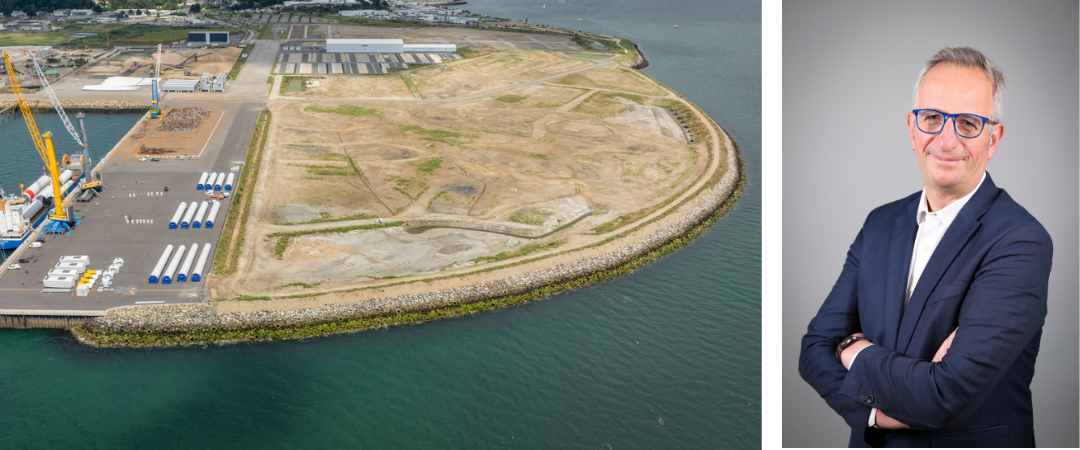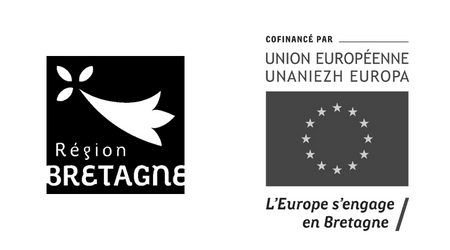From 23 to 25 April, Brest will be hosting FOWT, a major event for the floating offshore wind sector. Organised by Pôle Mer Méditerranée and France Renouvelables, this event will showcase Brittany and the region’s organisations working to develop these technologies. BrestPort ranks among these organisations, with its dedicated infrastructures geared towards the different steps in the marine energy value chain. Eolink utilises BrestPort’s facilities for the construction of its floating wind turbine. We talked to Christophe Chabert, Chairman of BrestPort’s Executive Board.
Can you walk us through the ties between BrestPort and the development of wind energy projects, in particular floating wind?
The Brittany Region’s Energy Plan, voted in under Jean-Yves Le Drian’s term of office in 2007, aspired to boost the region’s energy production capacity. It aimed to do so largely thanks to an extremely strong driver: the development potential of floating wind power. For this to come to fruition, a logistics platform was needed. A structuring investment in the port of Brest was launched in 2013 to build an infrastructure devoted to the development of offshore renewable energies, with a particular focus on floating wind. This is how Brest became one of the principle industrial hubs for floating wind power.
How much was invested in BrestPort to secure its floating wind development capacity?
In total, €250 million were invested to develop a terminal entirely dedicated to marine renewable energy, with a surface area of 40 hectares, i.e. the equivalent of 100 football pitches, with a loading bearing capacity ranging from 10 up to 64 t/m², and featuring a 400 m-long dock for heavy load handling. These vast dimensions reflect the ambitions of the renewable offshore energy sector. Today, Brest plays a pivotal role in the logistics of offshore wind farm deployment in France, with a view to achieving the double goal of energy sovereignty and the development of a Breton industry built on offshore renewables.
The reinforcement of Brest’s polder has been finalised, so as not only to address logistical issues but also to lay the groundwork for an industrial chain in order to offer the different players lasting, economically profitable solutions to rapid launch their floats.
What makes Brest’s port a solid choice for developing floating wind projects?
In addition to the industrial aspects I previously mentioned, there are strong dynamics driven by the region through Bretagne Ocean Power. A number of stakeholders are involved with the platform. We can also draw on our status as a major industrial player in ship repair and logistics. The skills of welders, mechanics and electricians, for instance, can contribute to creating and structuring a lasting offshore renewables sector. Bretagne Ocean Power works together with BrestPort to identify companies with relevant skills, in particular through BPN (Bretagne Pôle Naval).
Locally, we also have France Énergies Marines, based in Plouzané, which works with the French sector but also internationally and draws on support from the maritime cluster Pôle Mer Bretagne Atlantique, the Brittany Region and the Technopôle Brest-Iroise to bring together all the assets to support wind farm construction, but also the design and R&D phases. This gives us a leading role to play in determining the future of marine energies.
Finally, in 2013, when the Brittany Region decided to invest in the port of Brest, it also decided to change its model. Previously, the port’s management had been based on ten-year concession agreements. In cooperation with the Finistère Chamber of Commerce and Industry, the decision was made to create a company capable of managing operations over a 40-year period. The Brittany Region is the majority shareholder in this entity, which combines the agility of a private company with the impact and backing of public shareholders. This long-term vision is a solid asset for us.
What ties are there between the port of Brest and its counterpart in Lorient?
You’d be hard pushed to talk about Brest without mentioning Lorient. The two infrastructures go hand-in-hand. By sharing our respective skills, we are able to provide our clients with the most comprehensive and consistent offer possible. Together, we developed InFlow, a project set to accelerate the development of floating wind for Brittany’s ports. This project encompasses the investments needed in Brest and Lorient. Our two structures are complementary to each other. Neither port alone would be capable of developing all MRE projects. Lorient has certain assets that strengthen its position for moorings and cables. We focus more on floats and, to some extent, integration. The InFlow project involved a call for expressions of interest through which, as hoped, we were able to explore the entire value chain with developers, bottom-fixed turbine specialists, floating wind specialists, industrial firms, and more.
The BrestPort Community brand was launched in May 2024. Can you explain what’s behind the concept?
BrestPort Community was the result of our desire to boost the port’s offering and brings together all of the port’s stakeholders. It puts a message out there, under a shared banner, about our drive to jointly develop the structure, in particular steering it towards offshore renewables. It is composed of BrestPort and UMBR (Union Maritime de Brest et de sa Région), which comprises 37 companies within the port. BrestPort Community thus aims to provide an optimal, coherent solution for the port’s regional and international clients.
Eolink chose Brest to build its floating wind turbine. What does this move mean for Brest’s port?
It is critical. We need to put our facilities to the test so as to pinpoint potential improvement opportunities for the development of the floating wind energy sector.
What is the outlook for wind energy in Brest?
The conflict in Ukraine has shown that we need to strengthen our energy sovereignty. To achieve carbon neutrality by 2050, we need to increase our current levels of electricity production by 30%. We must therefore find other energy sources, and wind power is one of them. It’s very interesting to see that virtually all the tenders have remained on track despite the political instability over the past year, because the successive governments have been aware that they have no choice but to develop wind energy. Brest sits at the intersection of three markets: Southern Brittany, Northern Brittany and the Celtic Sea. Today, we’re bang in the centre of the area where floating wind is set to develop.

